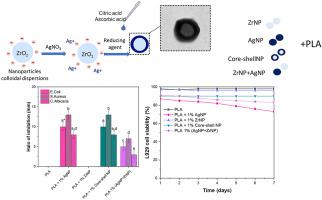Journal of the Mechanical Behavior of Biomedical Materials ( IF 3.9 ) Pub Date : 2021-08-21 , DOI: 10.1016/j.jmbbm.2021.104726 Anne Caroline da Silva Rocha 1 , Marcelo Vítor Dos Santos Pinheiro 1 , Lívia Rodrigues de Menezes 1 , Emerson Oliveira da Silva 1

|
Antimicrobial nanoparticles perform a vast and promising strand of applications, among which, the silver ones stand out due to their broad antimicrobial spectrum. However, their toxicological potential in addition with their not always satisfying mechanical properties limit their wider application. In this sense, the use of core-shell systems can generate materials with improved properties. Thus, the goal of the present work was to obtain zirconia-silver core-shell nanoparticles and, after that, evaluate their properties in systems based on poly(lactide) PLA. Systems containing silver nanoparticles (AgNP), zirconium oxide (ZrNP), a physical mixture of both particles and core-shell nanoparticles (Core-shell NP) were evaluated. The Core-shell NP were characterized by dynamic light scattering (DLS), Energy Dispersive X-Ray (EDX), transmission electronic microscopy (TEM), and antimicrobial activity. The nanocomposite films were evaluated by Fourier transform infrared analysis (FTIR), thermogravimetric analysis (TGA), nano-hardness, tensile strength test, cytotoxicity, and antimicrobial activity. The results obtained from the DLS and EDX analyses confirmed the obtaining of systems covered with silver. Through the TEM analysis, the formation of the core-shell structure with a diameter of about 100 nm was observed. The films containing core-shell NP presented antimicrobial activity with a profile correspondent to the one observed for AgNP. As for cytotoxicity, these particles proved to be less cytotoxic and achieved higher values of hardness (10%), modulus (40%), and toughness (28%) than those observed for AgNP, and these properties were lower than those observed for ZrNP. The core-shell NP also exhibited even greater antimicrobial activities, less cytotoxicity, and largest elastic modulus (17%) than the physical mixture of the particles.
中文翻译:

基于氧化锆的包覆银的核壳纳米粒子是获得具有良好机械性能和较低细胞毒性的抗菌纳米复合材料的有利视角
抗菌纳米粒子具有广泛而有前景的应用,其中,银纳米粒子因其广泛的抗菌谱而脱颖而出。然而,它们的毒理学潜力以及它们并不总是令人满意的机械性能限制了它们的更广泛应用。从这个意义上说,核壳系统的使用可以产生具有改进性能的材料。因此,本工作的目标是获得氧化锆-银核-壳纳米粒子,然后在基于聚(丙交酯)PLA 的系统中评估它们的性能。评估了包含银纳米粒子 (AgNP)、氧化锆 (ZrNP)、粒子和核壳纳米粒子 (核壳 NP) 的物理混合物的系统。核壳 NP 通过动态光散射 (DLS)、能量色散 X 射线 (EDX)、透射电子显微镜 (TEM) 和抗菌活性。通过傅里叶变换红外分析 (FTIR)、热重分析 (TGA)、纳米硬度、拉伸强度测试、细胞毒性和抗菌活性对纳米复合膜进行了评估。从 DLS 和 EDX 分析获得的结果证实了获得银覆盖的系统。通过TEM分析,观察到直径约100nm的核壳结构的形成。含有核壳 NP 的薄膜表现出抗菌活性,其曲线与对 AgNP 观察到的曲线一致。至于细胞毒性,与 AgNP 观察到的相比,这些颗粒被证明具有较低的细胞毒性,并获得了更高的硬度 (10%)、模量 (40%) 和韧性 (28%),并且这些特性低于 ZrNP 所观察到的那些.



























 京公网安备 11010802027423号
京公网安备 11010802027423号